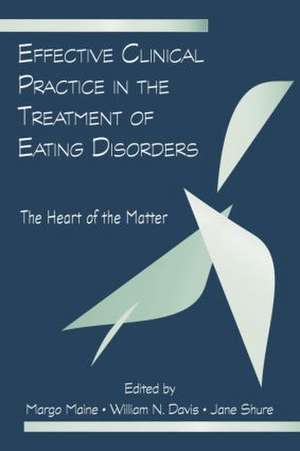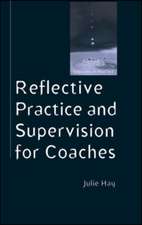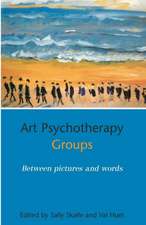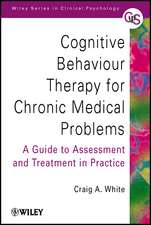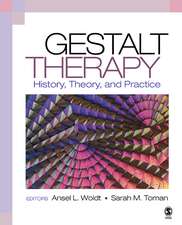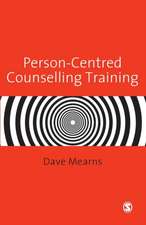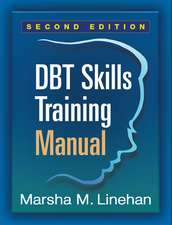Effective Clinical Practice in the Treatment of Eating Disorders: The Heart of the Matter
Editat de Margo Maine, William N. Davisen Limba Engleză Paperback – 19 aug 2015
| Toate formatele și edițiile | Preț | Express |
|---|---|---|
| Paperback (1) | 417.68 lei 6-8 săpt. | |
| Taylor & Francis – 19 aug 2015 | 417.68 lei 6-8 săpt. | |
| Hardback (1) | 1105.31 lei 6-8 săpt. | |
| Taylor & Francis – 20 oct 2008 | 1105.31 lei 6-8 săpt. |
Preț: 417.68 lei
Preț vechi: 439.67 lei
-5% Nou
Puncte Express: 627
Preț estimativ în valută:
79.92€ • 83.66$ • 66.52£
79.92€ • 83.66$ • 66.52£
Carte tipărită la comandă
Livrare economică 31 martie-14 aprilie
Preluare comenzi: 021 569.72.76
Specificații
ISBN-13: 9781138881716
ISBN-10: 1138881716
Pagini: 251
Ilustrații: 1 black & white tables
Dimensiuni: 152 x 229 x 22 mm
Greutate: 0.39 kg
Ediția:1
Editura: Taylor & Francis
Colecția Routledge
Locul publicării:Oxford, United Kingdom
ISBN-10: 1138881716
Pagini: 251
Ilustrații: 1 black & white tables
Dimensiuni: 152 x 229 x 22 mm
Greutate: 0.39 kg
Ediția:1
Editura: Taylor & Francis
Colecția Routledge
Locul publicării:Oxford, United Kingdom
Public țintă
Professional Practice & DevelopmentCuprins
Part I: Effective Clinical Practices: Approaches. Maine, Beyond the Medical Model: A Feminist Frame for Eating Disorders. Emmett, Wholeness and Holiness: A Psychospiritual Perspective. Davis, Individual Psychotherapy for Anorexia Nervosa and Bulimia: Making a Difference. Burgard, Developing Body Trust: A Body-positive Approach to Treating Eating Disorders. Part II: Effective Clinical Practice: Methods. Wingate, Holistic Integrative Psychiatry and the Treatment of Eating Disorders. Bunnell, Countertransference in the Psychotherapy of Patients with Eating Disorders. Maier, Family Therapy with Eating Disorders: Creating an Alliance for Change. McGilley, Sacred Circles: Feminist-oriented Group Therapy for Adolescents with Eating Disorders. Rabinor, Bilich, Treating Eating Disorders: The Healing Power of Guided Imagery. Ressler, BodyMind Treatment: Connecting to Imprinted Emotions and Experiences. Part III: Effective Clinical Practices: Special Themes. Shure, Weinstock, Shame, Compassion, and the Journey Toward Health. Costin, The Embodied Therapist: Perspectives on Treatment, Personal Growth, and Supervision Related to Body Image. Whitehead-LaBoo, Connecting Through Difference: Therapeutic Use of Self to Promote Eating Disorder Recovery. Zimmer, Therapy Redux: The Evolution of a Treatment Relationship. Bloomgarden, Working with People Who Live Dangerously: Perspectives on Managing Negative Countertransference During the Treatment of Eating Disorders. Sesan, Forgiveness: The Final Frontier in Recovery from an Eating Disorder.
Notă biografică
Margo Maine, PhD, FAED, is a clinical psychologist who has specialized in the treatment and prevention of eating disorders for over 25 years. She is a senior editor of Eating Disorders: The Journal of Treatment and Prevention, a Founding Member and Fellow of the Academy for Eating Disorders, and a member of the Founder’s Council and past president of the National Eating Disorders Association.
William N. Davis, PhD, FAED is a member of the Editorial Board of Eating Disorders: The Journal of Treatment and Prevention and the Journal of College Student Psychotherapy. He has published and lectured frequently on the theory and treatment of eating disorders is in private practice in New York and Pennsylvania.
Jane Shure, PhD, LCSW, is on faculty at the Kripalu Center in Lenox, MA, where she leads Calming Your Inner Critic, a weekend workshop. She helped found and develop the "Inside Outside Self-Discovery Program," a self-esteem based prevention curriculum for middle-school girls, and co-created www.selfmatters.org, a website dedicated to strengthening self-esteem. She is a board member of A Chance to Heal Foundation.
William N. Davis, PhD, FAED is a member of the Editorial Board of Eating Disorders: The Journal of Treatment and Prevention and the Journal of College Student Psychotherapy. He has published and lectured frequently on the theory and treatment of eating disorders is in private practice in New York and Pennsylvania.
Jane Shure, PhD, LCSW, is on faculty at the Kripalu Center in Lenox, MA, where she leads Calming Your Inner Critic, a weekend workshop. She helped found and develop the "Inside Outside Self-Discovery Program," a self-esteem based prevention curriculum for middle-school girls, and co-created www.selfmatters.org, a website dedicated to strengthening self-esteem. She is a board member of A Chance to Heal Foundation.
Recenzii
Review #1) by Kathleen Burns Kingsbury, LMHC, Co-Author, Weight Wisdom: Affirmations for Food and Body Concerns
I would recommend a shorter title for the book. I do like the subtitle "Heart of the Matter". I realize the book title is important on several levels, but if there was a way to use this and add one or two more words I think this would be more appealing and more useful in the marketing of the book. The cover art could follow along with this theme and be very interesting – or maybe a client’s work – as well.
Review #2) by Susan Albers:
Audience/Course/Market
A secondary market would be families. However, as the book proposal mentions, the buyer would really need to have some grounding or a sophisticated knowledge of eating disorders. It has a complexity that would not be grasped by a lay person nor would it be particularly useful for the patient. This book seems to be clearly geared toward the professional.
If the work is intended as a textbook,
Contents
5. Competing Books/Literature in the Field: How does this work relate to literature already published in the field? With what book(s) does it most closely compete? (Please indicate author, title, publisher, and year of publication). If it is intended as a textbook, with what other texts will it compete, and how does this book compare? Please compare and contrast the proposed book with the book you now use (or those you are familiar with), or with the other books in the field, addressing issues of content, length, and format, if possible.
The Eating Disorder Sourcebook: Costin 17.95. This book contains a collection of diverse topics.
6. Organization/Table of Contents: Are all of the topics you find necessary in this type of book covered? Are there any topics you feel that should be relocated, removed, or added?
See comments in the next section
7. Coverage: Based on the table of contents and sample chapter(s), do you believe the authors covered each of the topics adequately? Can you suggest any additions or deletions? Does the overall length appear to be satisfactory? Too long? Too short?
It appears to be an adequate length. The proposed number of pages for each chapter provides room for theory in the beginning, a clinical vignette and discussion.
8. Writing Style and Level: Is the writing style and the reading level satisfactory and appropriate for the market? (Please note that this manuscript has not yet been copyedited, so there may still be some typographical or other minor grammatical/stylistic errors. Some errors are normal at this stage; however, do feel free to comment on the overall quality of the writing, especially if you believe that the number of errors exceeds is excessive).
The sample chapter was very easy to read and on target with the level of reading for professionals. The clinical example was a highlight of this chapter. It is difficult to judge the overall book as each author will bring their own writing style.
It was curious why the author indicated that "women who struggle with an eating disorder also have a shame disorder (p.3). I would imagine that shame is the root of the issue for men and women with eating disorders?
9. Format: Do you believe this book would be best offered in a hardcover or soft cover format? Are there any other features you would find appropriate or appealing in the format (e.g. a special trim size or a spiral binding, etc.)?
Soft cover would likely be more appealing. A hardcover may discourage professionals who are not taking a class from buying this text.
10. Special Features: Are there any special features you find particularly appealing? Are there any other features you could recommend that would make the book more useful?
11. Title: Please comment on the proposed title (and subtitle) for this proposed book. Does it accurately and clearly describe its content and intended purpose? Is it a "catchy" title, which would make you want to pick up – and read – the book? Please explain. Do you have any alternative titles or subtitles that you believe would be better?
The title is sufficient. It’s very to the point. Effective Clinical Practice in the Treatment of Eating Disorders: The Heart of the Matter. It’s not particularly "catchy" but it accurately describes the book. I like the slant toward "clinical practice." What is obvious and a selling point about this book is that these are clinicians.
I like this line from her proposal which could be a title. "The heart of the matter: the therapeutic interventions and interactions that comprise life-changing treatment for eating disorders" It also helps to narrow down the focus on the book. The title seems way too broad. Or, perhaps the title needs to include something about the patient therapist healing relationship as this seems to be the primary theme?
Or, What Really Works? The Most Effective Clinical Practices Used by Eating Disorder Professionals.
12. Other: Please feel free to comment on any other areas not covered above, or to make additional suggestions for special features that you find attractive and appropriate.
Recommendation
The Heart of the Matter is a solid primer on eating disorder treatment. As the title suggests, it gets to the heart of the issue by exploring from many angles the psychological roots of one of the most challenging and perplexing mental health issues of our time.
The Heart of the Matter shows how experienced therapists build a healing, trusting and life changing relationship with their patients. It explains the mystery behind what therapist really do to help their patients battle this devastating disease.
You can use this.
Review #3 by Linda Glass:1. I consider the primary audience for the book to be professional clinicians, working in the field of eating disorders with a wide range of clients. The secondary audience may be other professionals involved in a treatment team to include physicians, nurses, nurse practitioners, nutritionists, and perhaps family members of those suffering as well.
3. I believe there is a great market for this book, as senior and new clinicians alike are yearning for specific hands-on approaches and concepts in their work with this very difficult and challenging population.
4. I was excited to read the sample chapter, and yet was still hoping that this chapter would go even deeper into examples of actual dialogue between therapist and client. When I was reading this chapter, while the dialogue included is helpful, in reality, this snippet of discussion would take place within about 7 minutes of one session. I long for more extended dialogue/examples of cases that often take years to complete...this may be beyond the scope of any book on the treatment of eating disorders, but I myself want validation of what the whole of treatment might look like--both successful and less successful. The table of contents looks great, and despite my personal wishes of more depth and detail, my overall impression of the book is very, very positive. I would look forward to reading it! I know there is a place for it within the field, it is timely, and my guess is it would have a fairly decent shelf life of years.
5. I thought the overview of related literature was accurate, and that this book would be a bright spot in current trends in the field of treatment.
6. I was impressed by the table of contents, as it seems to include a wide range of topics, themes, and treatment complications that all therapists working in this field will inevitably address. I like the format of an edition compiled by senior clinicians, all of whom will bring their own perspective and experiences to their individual chapters.
7. I do believe, as I began to address above, that the chapters could go into more depth, to give more detailed examples of shame, for example, in the middle of treatment, and as treatment might be concluding..to write about the therapist countertransference reactions to the clients shame and the different manifestations of it (sometimes outburst of anger and rage toward the therapist are indeed manifestations of shame that are challenging and hard and tedious to bear!) Without knowing the length of the other chapters, I would say overall that the length seems adequate, but could be added to with appreciation from the readers.
8. I appreciated the writing style, and the reading level is satisfactory to the market. The professional, yet accessible tone was great.
9. I would buy the book in either hardcover or softcover format. I think it would appeal more to professionals to come out in hardcover.
10. I especially appreciated the chapter targeted toward group work with adolescents. So much of my professional work has been with this population, and so much of the literature does not differentiate the special concerns or needs of this population. I hope this chapter is especially detailed and in depth! I hope to see specific exercises, end-of-chapter questions and explorations in particular in all the chapters.
11. I liked the title, but didn't love it. The first part suggests a real academic tone, the subtitle suggests something very different. I understand the implication that the both the science and art of psychotherapy are important but think the title might confuse some potential readers about the content. I am not sure about another title, just offering some thoughts.
13. I do recommend this book for publication. The editors and authors are all well-known practitioners in the field, most of whom I have heard speak, or have read their previous articles and/or books. They are respected, and I am engaged by their sensitivity, passion, and deep desire to facilitate healing for those struggling with eating disorders. Theirs are authentic voices of hope amidst lives of despair. I believe that those in the field of eating disorder work will benefit greatly from a compilation of senior clinician's experiences, views, lessons, and questions regarding the present and the future of this work. I look forward to the publication of this book!
"It is a goldmine of clinical pearls, offering a bird’s eye view into treatment philosophy and implementation from a feminist perspective…this volume contains an in-depth look at the ‘heart of the matter,’ elucidating the underlying emotional, interpersonal and spiritual conditions associated with the disease – matters which at some level transcend the race, gender, and socio-economic status of sufferers. The book is unique in the way in which philosophical matters are interwoven with an abundance of the practical…well-written, easy-to-read, and aesthetically pleasing on the bookshelf. I recommend this book to any clinicians treating women with eating disorders…the years of clinical experience and wisdom contained in the volume add an invaluable resource to the treatment and recovery literature." – Kimberly Dennis, M.D., Eating Disorders
"The author list...represents a body of seasoned practitioners who collectively represent centuries of clinical experience with eating disorders. The depth and breadth of experience coupled with eloquent writing and clinical vignettes results in a rich volume that elevates us beyond the day to day struggles of deal with insurance companies and hospital administration and reminds us of some truly fundamental principles of conducting psychotherapy with individuals with eating disorders. This book speaks in one voice and never veers toward the choppy. Any clinician involved in the treatment of eating disorders would benefit from a deep and careful read of this book. This volume could meaningfully be used in any educational setting in which providers are being trained to conduct therapy with individuals with eating disorders. Regardless of therapeutic orientation, the clinical wisdom in this book will assist with developing a healthy and respectful stance towards patients with eating disorders." -Cynthia M. Bulik in Sex Roles
"A goldmine of clinical pearls, offering a bird's eye view into treatment philosophy and implementation from a feminist perspective. This book is unique in the way in which philosophical matters are interwoven with an abundance of the practical, gleaned from clinical vignettes based on real life therapy with real life women seeking recovery. This volume is wekk-written, easy to read, and aesthetically pleasing on the bookshelf. I recommend this book to any clinicians treating women with eating disorders. The years of clinical experience and wisdom contained in the volume add an invaluable resource to the treatment and recovery literature." - Kimberly Dennis, Medical Director, Timberline Knolls Residential Treatment Center, Lemont, IL, USA
- The primary audience of the book is clinicians with a specialty in eating disorders, body image and other related diagnosis. The secondary audience is general clinicians such as RDs, PCPS and adjunctive treatment providers.
- I would definitely use this book as a text for my graduate course on the treatment of eating disorders. I believe this text book could be used as either a primary source or a supplemental text depending on the course and the teacher’s style.
- I currently use Laura Goodman’s and Mona Villapiano’s text entitled Eating Disorders published by Brunner-Rutledge as the main text. I chose this text for two reasons. First it is easy to read and clearly discusses treatment of eating disorders in a succinct way. Secondly, my students are both clinically trained and from other backgrounds such as teaching. Therefore, this text does a nice job for the lay person as well.
- I liked the concept overall. Having the pioneers in the field write about their own clinical experience and learning process as well as give advice about what works and what does not is invaluable. I also liked the idea that this text could be used as an alternative to the medical model. This is the way I practice so it would be easy to use this text in my supervision of clinicians or in my graduate courses.
- I agree with the assumptions in the book and like the idea that the goal of treatment is to empower the client to take a more active role. Also I use a lot of CBT in my work but know from experience that it takes many other modalities to fully address the underlying issues and help someone fully recovery from a clinical eating disorder or a body image issue.
- There is definitely a place in the field for this text.
Page 2
- I think that the perspective of the book is original as these are the pioneers in a field that is still very young. Many folks go to workshops to hear these authors speak. For those who are unable to attend or who want to hear more from them would buy this book. I especially like the idea of clinicians reflecting on there own professional growth. I really think that this is what is most helpful to those of us who are more senior in the field and find it hard to find a book that is not "too basic" about the treatment.
- I believe the material is timely and could become a classic in the field. It is important to document the history of treatment and as previously mentioned people such as Margo Maine and Bill Davis entered this field at a time when little was known about effective treatment. I also like that the book is based on clinical practice not clinical research. For many of us, this is a more useful text.
- I would defer to the review in the book proposal as it is very thorough and complete.
- I would like to see a chapter or two on Family Therapy – maybe one on the Maudsley Approach and the other on traditional Family therapy. I think this is missing in the text and is often missing at conferences. It is a vital part of the recovery process especially for teens and should be included. Also I did not see mention of binge eating disorders and would like to see this included along with clinical thoughts and reflections on treating anorexia and bulimia. The other topics were all interesting and seemed useful to include.
- While the text is not completed, it seemed that the length was adequate. Once again, including the family therapy/systems piece would be important and would add to the overall size of the book.
- The writing style seemed appropriate for the audience. I like Dr. Emmett’s spirituality chapter but would want him to get clearer as to what he is writing about and what the structure would be as I was a bit confused by his write up. Although I know Steve would be an invaluable contributor to the process.
- I think this type of text lends itself to a hardcover book. However, it would be great to have it in soft cover to make it more affordable for those newer clinicians and those in adjunctive specialties to be able to include in their resource library.
I would recommend a shorter title for the book. I do like the subtitle "Heart of the Matter". I realize the book title is important on several levels, but if there was a way to use this and add one or two more words I think this would be more appealing and more useful in the marketing of the book. The cover art could follow along with this theme and be very interesting – or maybe a client’s work – as well.
- No other comments.
- I would highly recommend this book for publication. I would definitely use it in my graduate level course and include it on my resource list when presenting workshops to providers on the topic of eating disorders and body image.
- Marketing Quote: Heart of the Matter is a unique collection of clinical wisdom from pioneers in the field of eating disorders. It is a must read for anyone interested in working in the field.
Review #2) by Susan Albers:
Audience/Course/Market
- Who do you consider to be the primary audience for the book? The secondary audience?
A secondary market would be families. However, as the book proposal mentions, the buyer would really need to have some grounding or a sophisticated knowledge of eating disorders. It has a complexity that would not be grasped by a lay person nor would it be particularly useful for the patient. This book seems to be clearly geared toward the professional.
If the work is intended as a textbook,
- For which course(s) would it be most appropriate?
Graduate School Courses
- Would the book be used as the main text or as a supplemental text?
Main Text
- Which book are you currently using for this course? (Please indicate author, title, publisher, and year of publication). Why did you choose it?
- Do you believe that the market for this book is growing, or, if the book is a text, do you see any trends in enrollment in this course?
Contents
- Overall Reaction: What is your general reaction to this proposal and sample chapter(s)?
- Do you find any of the features of the text particularly appealing? Is the book based on any assumptions with which you agree? Disagree? Please explain.
The first reaction to the proposal was that it is written by an incredible group of professionals. All of the contributors are extremely well respected and frequently give presentations at Renfrew and other conferences. Many professionals would buy this book just based on the quality of the contributors.
The most appealing aspect of this text was the experience each of these professionals brings, the solid nature of this book and the clinical vignettes.
- Is there a place for this book in its field of study?
Yes.
- Does it appear to be written from an original perspective? Is the book on the "leading edge" of its field, or fairly standard in its approach?
This book has a very solid perspective. I’ve read similar topics. Issues that were interesting and unique are the chapter on shame and the psychospiritual perspective
There doesn’t seem to be a very tight consistent theme of this book. The issue of eating disorder treatment is so broad. Perhaps it could have a narrower focus in the title such as a feminist perspective on clinical practice, the relationship between therapist and patient, or a holistic approach to clinical practice etc. Realistically, it is difficult to comment on all the effective clinical practices and there are many effective practices that are missing. These are a few good ones but I wouldn’t want to sell this as only effective methods.
I noted that there are four chapters on countertransference/therapists use of self. It appears that majority are talking about how a clinician navigates the challenging and scary waters of working with an eating disorder client. I think this highlights that the majority of the healing comes from a solid relationship with the therapist. Perhaps the introduction would help pull these chapters all together.
- Is the material timely? What would be the book’s potential shelf-life?
5. Competing Books/Literature in the Field: How does this work relate to literature already published in the field? With what book(s) does it most closely compete? (Please indicate author, title, publisher, and year of publication). If it is intended as a textbook, with what other texts will it compete, and how does this book compare? Please compare and contrast the proposed book with the book you now use (or those you are familiar with), or with the other books in the field, addressing issues of content, length, and format, if possible.
The Eating Disorder Sourcebook: Costin 17.95. This book contains a collection of diverse topics.
6. Organization/Table of Contents: Are all of the topics you find necessary in this type of book covered? Are there any topics you feel that should be relocated, removed, or added?
See comments in the next section
7. Coverage: Based on the table of contents and sample chapter(s), do you believe the authors covered each of the topics adequately? Can you suggest any additions or deletions? Does the overall length appear to be satisfactory? Too long? Too short?
It appears to be an adequate length. The proposed number of pages for each chapter provides room for theory in the beginning, a clinical vignette and discussion.
8. Writing Style and Level: Is the writing style and the reading level satisfactory and appropriate for the market? (Please note that this manuscript has not yet been copyedited, so there may still be some typographical or other minor grammatical/stylistic errors. Some errors are normal at this stage; however, do feel free to comment on the overall quality of the writing, especially if you believe that the number of errors exceeds is excessive).
The sample chapter was very easy to read and on target with the level of reading for professionals. The clinical example was a highlight of this chapter. It is difficult to judge the overall book as each author will bring their own writing style.
It was curious why the author indicated that "women who struggle with an eating disorder also have a shame disorder (p.3). I would imagine that shame is the root of the issue for men and women with eating disorders?
9. Format: Do you believe this book would be best offered in a hardcover or soft cover format? Are there any other features you would find appropriate or appealing in the format (e.g. a special trim size or a spiral binding, etc.)?
Soft cover would likely be more appealing. A hardcover may discourage professionals who are not taking a class from buying this text.
10. Special Features: Are there any special features you find particularly appealing? Are there any other features you could recommend that would make the book more useful?
- If the book is intended as a textbook or workbook for support groups, etc., please comment on quality and amount of exercises, activities, end-of-chapter questions, summaries, etc.
11. Title: Please comment on the proposed title (and subtitle) for this proposed book. Does it accurately and clearly describe its content and intended purpose? Is it a "catchy" title, which would make you want to pick up – and read – the book? Please explain. Do you have any alternative titles or subtitles that you believe would be better?
The title is sufficient. It’s very to the point. Effective Clinical Practice in the Treatment of Eating Disorders: The Heart of the Matter. It’s not particularly "catchy" but it accurately describes the book. I like the slant toward "clinical practice." What is obvious and a selling point about this book is that these are clinicians.
I like this line from her proposal which could be a title. "The heart of the matter: the therapeutic interventions and interactions that comprise life-changing treatment for eating disorders" It also helps to narrow down the focus on the book. The title seems way too broad. Or, perhaps the title needs to include something about the patient therapist healing relationship as this seems to be the primary theme?
Or, What Really Works? The Most Effective Clinical Practices Used by Eating Disorder Professionals.
12. Other: Please feel free to comment on any other areas not covered above, or to make additional suggestions for special features that you find attractive and appropriate.
Recommendation
- Based on your comments above, please choose one of the following. For any choice you make, please briefly summarize your overall impressions and the primary recommendations for improving the book (or why you feel it should not be signed).
- I recommend this book for publication. If designed as a text, would you use the book for your courses? Why or why not?
This is a fabulous group of clinicians and researchers. It is a very solid book. If I was teaching a class this semester on eating disorders, it would definitely be on my list. At this time, the number of classes specifically on eating disorders is growing. In the past, unfortunately, one class has been devoted to eating disorders.
I would like another chapter or two on a very new and upcoming topic like the Maudsely method, DBT, ACT, residential treatment issues, mindful eating, cutting, men or young children etc. I really think it would help to balance out the book. It would attract people who already are familiar with eating disorders but want to learn new information.
This book seems to focus on the foundation of treatment and the therapist/client relationship. It does not try to explain the other types of treatment such as medication etc. Perhaps this should be somehow noted.
The Heart of the Matter is a solid primer on eating disorder treatment. As the title suggests, it gets to the heart of the issue by exploring from many angles the psychological roots of one of the most challenging and perplexing mental health issues of our time.
The Heart of the Matter shows how experienced therapists build a healing, trusting and life changing relationship with their patients. It explains the mystery behind what therapist really do to help their patients battle this devastating disease.
You can use this.
Review #3 by Linda Glass:1. I consider the primary audience for the book to be professional clinicians, working in the field of eating disorders with a wide range of clients. The secondary audience may be other professionals involved in a treatment team to include physicians, nurses, nurse practitioners, nutritionists, and perhaps family members of those suffering as well.
3. I believe there is a great market for this book, as senior and new clinicians alike are yearning for specific hands-on approaches and concepts in their work with this very difficult and challenging population.
4. I was excited to read the sample chapter, and yet was still hoping that this chapter would go even deeper into examples of actual dialogue between therapist and client. When I was reading this chapter, while the dialogue included is helpful, in reality, this snippet of discussion would take place within about 7 minutes of one session. I long for more extended dialogue/examples of cases that often take years to complete...this may be beyond the scope of any book on the treatment of eating disorders, but I myself want validation of what the whole of treatment might look like--both successful and less successful. The table of contents looks great, and despite my personal wishes of more depth and detail, my overall impression of the book is very, very positive. I would look forward to reading it! I know there is a place for it within the field, it is timely, and my guess is it would have a fairly decent shelf life of years.
5. I thought the overview of related literature was accurate, and that this book would be a bright spot in current trends in the field of treatment.
6. I was impressed by the table of contents, as it seems to include a wide range of topics, themes, and treatment complications that all therapists working in this field will inevitably address. I like the format of an edition compiled by senior clinicians, all of whom will bring their own perspective and experiences to their individual chapters.
7. I do believe, as I began to address above, that the chapters could go into more depth, to give more detailed examples of shame, for example, in the middle of treatment, and as treatment might be concluding..to write about the therapist countertransference reactions to the clients shame and the different manifestations of it (sometimes outburst of anger and rage toward the therapist are indeed manifestations of shame that are challenging and hard and tedious to bear!) Without knowing the length of the other chapters, I would say overall that the length seems adequate, but could be added to with appreciation from the readers.
8. I appreciated the writing style, and the reading level is satisfactory to the market. The professional, yet accessible tone was great.
9. I would buy the book in either hardcover or softcover format. I think it would appeal more to professionals to come out in hardcover.
10. I especially appreciated the chapter targeted toward group work with adolescents. So much of my professional work has been with this population, and so much of the literature does not differentiate the special concerns or needs of this population. I hope this chapter is especially detailed and in depth! I hope to see specific exercises, end-of-chapter questions and explorations in particular in all the chapters.
11. I liked the title, but didn't love it. The first part suggests a real academic tone, the subtitle suggests something very different. I understand the implication that the both the science and art of psychotherapy are important but think the title might confuse some potential readers about the content. I am not sure about another title, just offering some thoughts.
13. I do recommend this book for publication. The editors and authors are all well-known practitioners in the field, most of whom I have heard speak, or have read their previous articles and/or books. They are respected, and I am engaged by their sensitivity, passion, and deep desire to facilitate healing for those struggling with eating disorders. Theirs are authentic voices of hope amidst lives of despair. I believe that those in the field of eating disorder work will benefit greatly from a compilation of senior clinician's experiences, views, lessons, and questions regarding the present and the future of this work. I look forward to the publication of this book!
"It is a goldmine of clinical pearls, offering a bird’s eye view into treatment philosophy and implementation from a feminist perspective…this volume contains an in-depth look at the ‘heart of the matter,’ elucidating the underlying emotional, interpersonal and spiritual conditions associated with the disease – matters which at some level transcend the race, gender, and socio-economic status of sufferers. The book is unique in the way in which philosophical matters are interwoven with an abundance of the practical…well-written, easy-to-read, and aesthetically pleasing on the bookshelf. I recommend this book to any clinicians treating women with eating disorders…the years of clinical experience and wisdom contained in the volume add an invaluable resource to the treatment and recovery literature." – Kimberly Dennis, M.D., Eating Disorders
"The author list...represents a body of seasoned practitioners who collectively represent centuries of clinical experience with eating disorders. The depth and breadth of experience coupled with eloquent writing and clinical vignettes results in a rich volume that elevates us beyond the day to day struggles of deal with insurance companies and hospital administration and reminds us of some truly fundamental principles of conducting psychotherapy with individuals with eating disorders. This book speaks in one voice and never veers toward the choppy. Any clinician involved in the treatment of eating disorders would benefit from a deep and careful read of this book. This volume could meaningfully be used in any educational setting in which providers are being trained to conduct therapy with individuals with eating disorders. Regardless of therapeutic orientation, the clinical wisdom in this book will assist with developing a healthy and respectful stance towards patients with eating disorders." -Cynthia M. Bulik in Sex Roles
"A goldmine of clinical pearls, offering a bird's eye view into treatment philosophy and implementation from a feminist perspective. This book is unique in the way in which philosophical matters are interwoven with an abundance of the practical, gleaned from clinical vignettes based on real life therapy with real life women seeking recovery. This volume is wekk-written, easy to read, and aesthetically pleasing on the bookshelf. I recommend this book to any clinicians treating women with eating disorders. The years of clinical experience and wisdom contained in the volume add an invaluable resource to the treatment and recovery literature." - Kimberly Dennis, Medical Director, Timberline Knolls Residential Treatment Center, Lemont, IL, USA
